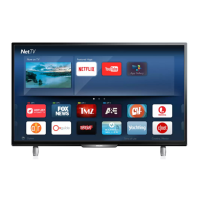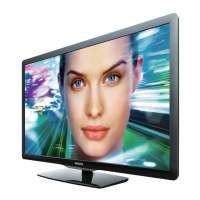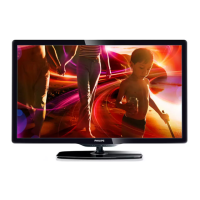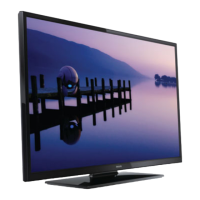Do you have a question about the Philips 40PFL8008K/12 and is the answer not in the manual?
Details on product support, getting started, user manuals, FAQs, software & drivers.
Details on how to connect the television.
Detailed overview of all physical connections on the TV set.
Safety regulations and procedures to follow during repair.
General warnings related to the product and its use.
Guidelines for placing the TV set for easy and safe servicing.
Instructions for removing the assembly or panel.
Details on affixing and mounting Ambilight units in the rear cover.
Information on SSB components and LVDS connector handling.
Instructions for re-assembling the TV set after repairs.
Explanation of Service Default Mode (SDM) and Service Alignment Mode (SAM).
Purpose and activation of Service Default Mode for pre-defined settings.
Information about Service Alignment Mode for adjustments.
Purpose and usage of Customer Service Mode for identifying set status.
Diagrams detailing the start-up process and present supplies.
Information about detected error codes and their logging.
Explanation of the error code buffer and how errors are logged.
Methods for clearing the error buffer.
Methods for clearing the error buffer.
Information on error detection mechanisms and logging.
Procedure for interpreting error codes via blinking LEDs.
Introduction to the blinking LED procedure for error identification.
Methods to activate the blinking LED procedure for error display.
Explanation of protection mechanisms within the set.
Explanation of software-related protections and fault conditions.
Guidance and tips for diagnosing and repairing faults.
Usage of CSM for dumping information to USB stick.
Description of the TV's power supply and distribution system.
Guidance on debugging DC/DC converters.
Recommendations for checking LED drivers when no picture or backlight issues occur.
Importance of checking display option codes after SSB replacement.
Instructions for replacing the SSB (Service Board).
Procedures for upgrading the TV's software.
Procedure for automatic software upgrade.
How to manually activate the back-up software upgrade application.
Steps for upgrading the Standby software via USB.
Information on the content and usage of one-zip software files.
Conditions and settings required for performing electrical adjustments.
Steps for setting correct options and storing aligned values to NVM.
Software-based calibration procedures.
Procedure for white point alignment using picture settings.
Ensuring correct communication with ICs by setting microprocessor options.
Introduction to microprocessor communication and IC addressing.
Importance of resetting NVM on a repaired SSB.
Summary of SAM modes and their functions.
Details on the power supply units and their function.
Information on ordering new power supply boards and replacing fuses.
Reference to figure 7-2 for the overall power architecture.
Overall block diagram of the TV system architecture.
Diagram showing power supply lines and voltage distribution.
Circuit diagram and PWB layout for the SSB board.
Circuit diagram for the Fusion supply.
Circuit diagram for the hybrid T/C tuner.
Circuit diagram for the satellite tuner.
Circuit diagram for the DVB-T2 channel decoder.
Circuit diagram for the DVBS/S2 channel decoder.
Circuit diagram of the Fusion processor.
Circuit diagram for the Fusion Umac controller.
Circuit diagram for the Umac 1 DDR3 memory.
Circuit diagram for the Umac 0 DDR3 memory.
Circuit diagram of the Fusion processor.
Circuit diagram for the Fusion power supply.
Schematic of the control, temperature sensor, and service interfaces.
Schematic of the LVDS interface for display connection.
Schematic for audio and video signal paths.
Circuit diagram for the Fusion power supply.
Schematic of the backlight microcontroller.
Circuit diagram for the Class-D audio amplifier.
Schematic for analogue external connections like SCART.
Schematic of the sensor board and Ambilight components.
Schematic of the HDMI connectors and associated circuitry.
Schematic for the HDMI Audio Return Channel functionality.
Schematic of the external USB connectors and circuitry.
Schematic of the Ethernet port and related circuitry.
Schematic of NAND flash, serial flash, and EEPROM components.
Circuit diagram for the Fusion power supply.
Circuit diagram for the Fusion power supply.
Circuit diagram for the Fusion power supply.
Circuit diagram for the Fusion power supply.
Schematic of the power supply section for the amplifier panel.
Schematic of the power supply circuitry.
| Style | Flat |
|---|---|
| Color | Black |
| Screen Type | LED |
| Stand Type | Tabletop swivel stand |
| Wall Mount | 200 x 200 mm |
| Tilt | - |
| Sound | Internal Speakers 30W (2x 15W) |
| Features | Ambilight 3-sided XL |
| Connectivity | Wi-Fi |
| SmartTV | Yes |
| Tuner | DVB-T/C/S/S2 |
| Video Playback: NTSC | PAL |
| Interface Connectors | HDMI connections: 4 |
| Operation Conditions | 5 °C to 35 °C |
| Screen Size | 40 inch / 102 cm |
| Aspect Ratio | 16:9 |
| Resolution | 1920x1080p |
| Refresh Rate | 1400 Hz Perfect Motion Rate |
| Viewing Angle | - |
| Response Time | - |
| Brightness | 450 cd/m² |
| Contrast Ratio | 500 |
| Color Support | - |
| Battery Type | Power Adapter |
| Power Supply | AC 220 - 240 V 50/60Hz |
| Power Consumption | 68 W |
| Depth with Stand | 205 mm |
| Height with Stand | 603 mm |
| Width with Stand | 910 mm |
| Net Weight with Stand | 12.4 kg |
| Depth without Stand | 32 |
| Height without Stand | 541 mm |
| Width without Stand | 910 mm |
| Net Weight without Stand | 11 kg |












